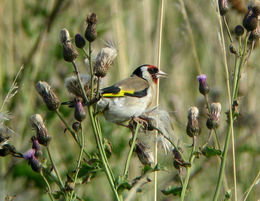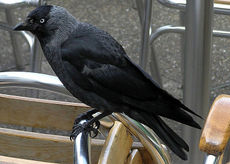The
British finches are made up of several species of
Finch which were formerly very popular as cage birds in
Great Britain. Nowadays they are not commonplace, but
are still keped by a few dedicated fanciers. British finches
are often associated with
Mules - a term used by
cagebird breeders to refer to hybrids of finch species bred
in captivity, such as that of a Goldfinch and Canary. There
are now strict ringing regulations on British finches in
places such as the UK, but they are still kept by
aviculturists who care for them in much the same way as
applies for canaries. The seed mixture in the UK known as
British Finch & Mule is their basic diet.
History
In
Victorian times British finches were hugely popular as cage
birds throughout the British Isles, often replacing
Canaries. Due to a lack of protection, thousands of
birds were captured for pets every year.

Goldfinches were once caught in thousands to be
kept as cage birds
Their popularity is reflected in the well known British
rhyme, Don't Dilly Dally on the Way, in the line, "I walked
behind wiv me old cock linnet..." referring to the Linnet, Carduelis cannabina.
Since the
Wildlife and Countryside Act 1981, it has been illegal
to capture, attempt to capture or sell any British bird, and
only those on Shedule 3 Part 1, may be sold if they are
closed ringed and proof can be given that it was bred in
captivity. Unfortunately, some people do still capture wild
birds using cruel methods such as illegal
bird lime.
Species
British finches are quite simply birds in the
Finch family which to this day live wild in the
British Isles.
The species most popular include:
- Genus
Fringilla - Bramblings and chaffinches
- Chaffinch (Fringilla coelebs)
Brambling (Fringilla montifringilla) (Note: this
species is often known in aviculture as the Bramble
finch)
- Genus
Carduelis -
Linnets, redpolls, goldfinches, greenfinches, some
siskins.
- Greenfinch (Carduelis chloris)
Redpoll (Carduelis sp.)
Siskin (Carduelis spinus )
Goldfinch (Carduelis carduelis )
Twite (Carduelis flavirostris)
Linnet (Carduelis cannabina)
- Genus
Loxia -
Crossbills
-
Common Crossbill (Loxia sp.) (Note:
In Victorian times the
Scottish Crossbill had not been identified)
- Genus
Pyrrhula -
Bullfinches
-
Bullfinch (Pyrrhula pyrrhula)
Mules and Hybrids
During the
Victorian era, it was found that if a British finch, e.g. a
Goldfinch, was crossed with a Canary, the result was an attractive looking, good
singing bird. The resulting birds were sterile, but continue
to be bred to this day under the name of Mules. Many
clubs specialise in Mules.
[1]
Also around this time a few people began to experiment
crossing British finches. The resulting birds, including
Siskin x Goldfinch and even such beauties as Bullfinch x
Crossbill also remain to this day, often winning prizes
at prestigious shows. The breeding of such hybrids can,
however be notriously difficult.
[2]
Other British birds
Not just finches were/are popular in British aviculture,
and the following have had a following of fanicers for many
years. They are all protected under the
Wildlife and Countryside Act 1981 as are finches.
Buntings
- Reed Bunting (Emberiza schoeniclus)
Yellowhammer (Emberiza citrinella) (Note: This species
is often known in aviculture as the Yellow Bunting)
Thrushes
- Blackbird (Turdus merula)
Song Thrush (Turdus philomelos)
Crows
- Jackdaw (Corvus monedula)
Jay (Garrulus glandarius)
Magpie (Pica pica)
Others
- Dunnock (Prunella modularis)
Starling (Sturnus vulgaris)

Birds such as Jackdaws were often kept by
children who marvelled at their ability to talk
in the days before parrots were readily
available
Other more unusual birds, including Redstarts and
Flycatchers, are sometimes bred by specialised owners.
See also
External links




